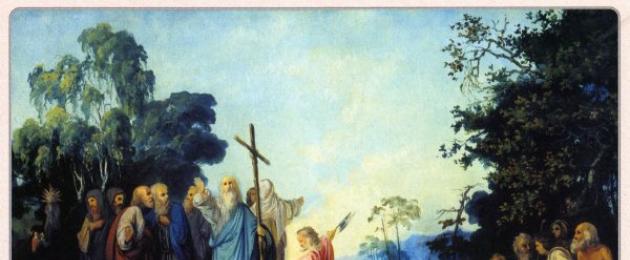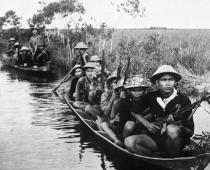The second part of a series of paintings on national history presents canvases by Russian painters who dedicated their paintings to significant events of the 10th-12th centuries: the Baptism of Russia and the triumph of Orthodoxy, as well as other important moments in the formation of Kievan Rus.
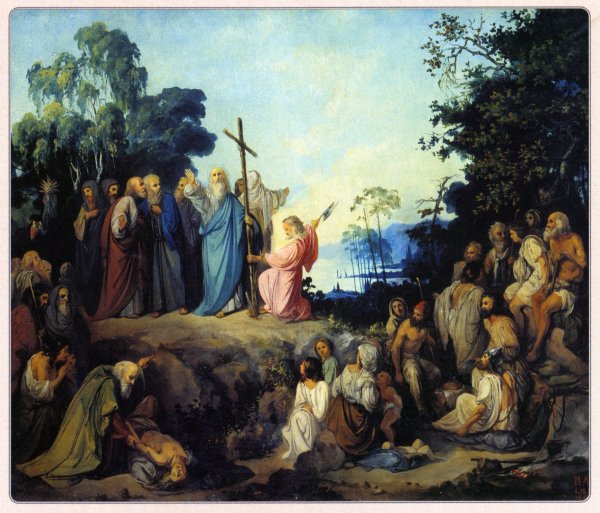
Nikolai Lomtev
Apostle Andrew the First-Called erects a cross on the mountains of Kiev.
1848
Jesus Christ bequeathed to his disciples - the apostles - to go to different countries and tell people about the new faith there. The Apostle Matthew walked around Palestine, Mark went to Egypt, Rome fell to Peter, and his brother Andrew had to sail to the Scythians - to unknown lands. That's how Andrei ended up on the hilly banks of the Dnieper. He climbed the highest hill, put a cross there and said that someday a beautiful city would be built on this place and people would believe in Jesus Christ and his teachings here.
As the Apostle Andrew the First-Called said, this is exactly what happened: on the banks of the Dnieper, a settlement of the Slavs first arose, which would become a city. By the name of the prince who founded it, it was called Kiev. In 988, the Grand Duke of Kiev Vladimir Svyatoslavich baptized the townspeople, and after them the whole of Kievan Rus. The son of Vladimir Svyatoslavich, Prince Yaroslav the Wise, built the beautiful Hagia Sophia. This temple still stands today, surprising everyone with its beauty.
Another interesting fact is known from the annals. After Kiev, Andrew the First-Called went to the Novgorod land, where he was most surprised at how the locals visit the bathhouse; they beat themselves with young rods, douse themselves with kvass and icy water.
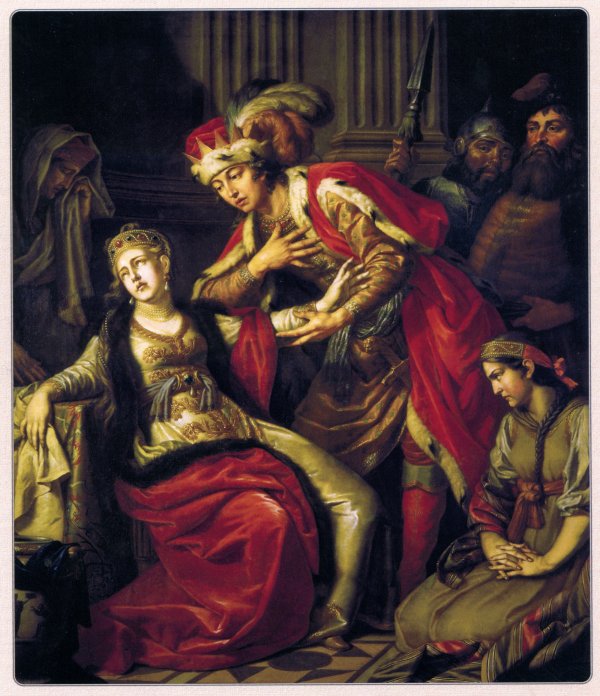
Anton Losenko
Vladimir and Rogneda
1770
Artist Anton Pavlovich Losenko was born in Ukraine into a Cossack family. He had a beautiful voice. The young man decided to become a singer and went to study in St. Petersburg. But the voice... was gone! Then Anton decided to try his hand at drawing - and the artist from Losenko turned out to be wonderful. He successfully graduated from the Academy of Arts and was sent on a business trip abroad to Italy and France to improve his skills. Upon returning to his homeland, he arranged an exhibition of his works, and the audience liked his paintings so much that the artist began to be called “Russian Raphael”.
He was the first to start painting scenes from Russian history. The most famous was his painting “Vladimir and Rogneda”.
Novgorod Prince Vladimir Svyatoslavich went to Kiev to avenge the death of his middle brother, Oleg, the eldest, Yaropolk.
On the way to Kiev, in the city of Polotsk, Vladimir Svyatoslavich wooed the daughter of the Polotsk prince, Rogneda, the bride of Yaropolk. But Rogneda only laughed at the son of a slave. The proud prince did not accept the failure and decided to take revenge: he gave vent to his anger: he captured the city, killed Rogneda's father and brothers, and nevertheless took a young woman as his wife. In Russia, they began to call her Gorislava.
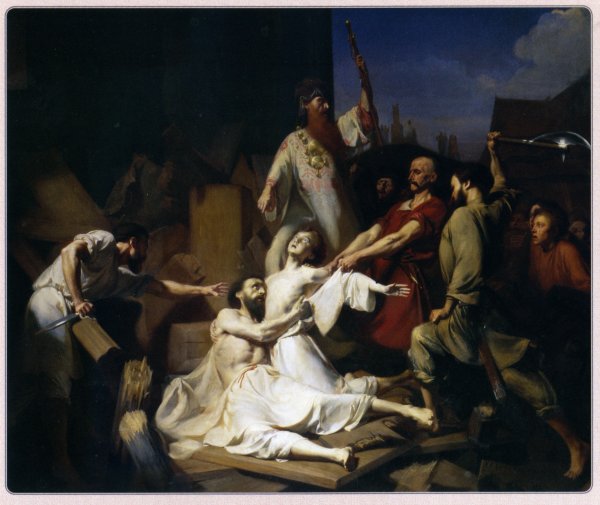
Pavel Sorokin
The first Christian martyrs under St. Vladimir
1852
The death of the first Christian martyrs, Theodore and John, is described in the annals. These are the Greek names given to father and son at baptism. What is known about them is that they were Scandinavians and arrived in Kiev from Byzantium, where Theodore received holy baptism.
Their deaths are told in different ways. Some write that Theodore and John were torn to pieces by local pagans because they disrespectfully spoke of the wooden statues of Perun and other pagan deities.
Other historians believe that after the victory of the princely squad over the Yatvag tribe, according to Varangian customs, it was supposed to bring human sacrifices to the gods. The Scandinavian warriors cast lots, and the choice fell on their two compatriots, who accepted the new faith.
The house of Christians was destroyed, and innocent people were put to cruel death.
On the spot where the house of Theodore and John stood, on the orders of Prince Vladimir, the Church of the Tithes was later built.
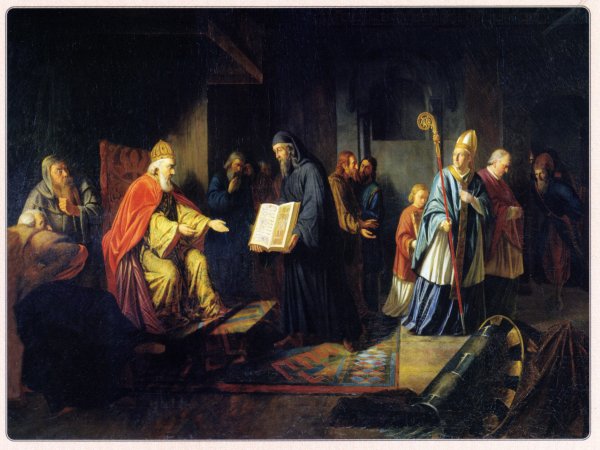
Ivan Eggink
Grand Duke Vladimir chooses religion.
1822
Vladimir, the youngest son of the Kiev prince Svyatoslav, having become the main - great - prince of Kievan Rus, began to think about faith for his subjects. He decided to send his associates to different countries: let them find out which God is stronger, who has “truth, power and glory.”
Envoys arrived and began to talk about what they had learned: in the East, among the Khazars - the Jewish faith, among the Volga Bulgarians - Islam, in the West - Catholicism, among the Greeks - Orthodoxy.
In the capital of Byzantium, Constantinople (then called Constantinople), there was a temple of the Wisdom of God - Sophia. And this church was so beautiful that it was impossible to look away from it. It was immediately clear that this is the house of God. This means that the Byzantine faith is the most correct and it suits the Russians the most. Vladimir decided to build the same temple in Kiev, so that in Kievan Rus there would be a house with God.
- In Byzantium, God himself abides with people! - the envoys said to the prince.
The prince liked the Orthodox faith, he remembered that Princess Olga, his grandmother, was one of the first Christians in Russia. Vladimir saw that the Christians, who were then persecuted, were dying with the name of Jesus Christ on their lips.
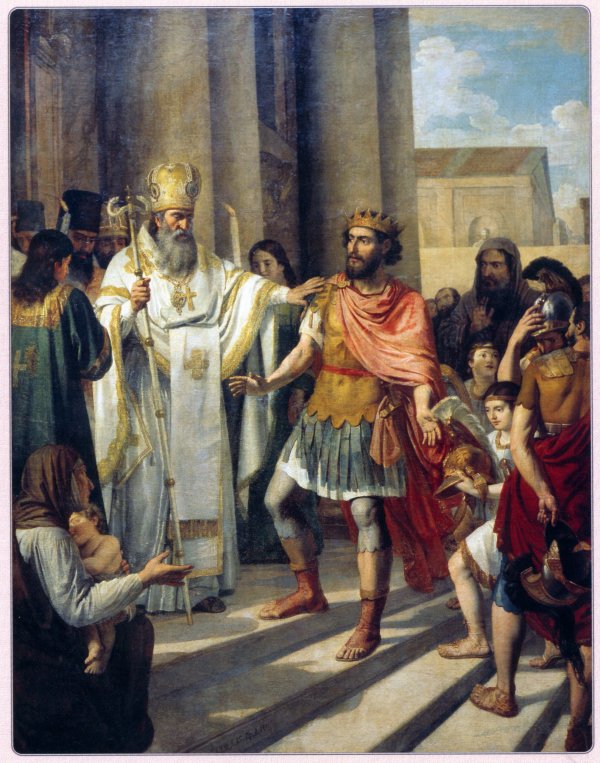
Andrey Ivanov
Baptism of Grand Duke Vladimir in Korsun.
1829
Before baptizing Russia, Grand Duke Vladimir Svyatoslavich was baptized himself, and this happened, according to one of the legends, in Korsun. So in the times of Kievan Rus the ancient city of Tauric Chersonese in the Crimea was called. Now this ancient city is located on the territory of modern Sevastopol.
It all started with the fact that the Byzantine emperor Vasily II the Bulgar-Slayer sent an embassy to the Kiev prince with a request to help suppress the rebellion of Varda Foki, which broke out in Byzantium. Vladimir Svyatoslavich agreed, but on the condition that the emperor's sister, Princess Anna, would become his wife. Vasily II agreed, but set a response condition - the baptism of Vladimir. That's what they decided on. The Kiev prince sent the Russian army to help the Byzantines, and he himself began to wait for the bride. But Princess Anne did not arrive.
Then the enraged Vladimir Svyatoslavich went on a campaign against Korsun, which he captured after a long siege. Vasily II was forced to fulfill his promise. Princess Anna, who arrived in Korsun, became the wife of the Kiev prince, who, in turn, was baptized.
There is another legend. Arriving in Korsun, Prince Vladimir suddenly became blind and regained his sight only after receiving holy baptism, thereby becoming even more established in the Orthodox faith. This moment is depicted in the painting by Andrei Ivanov.
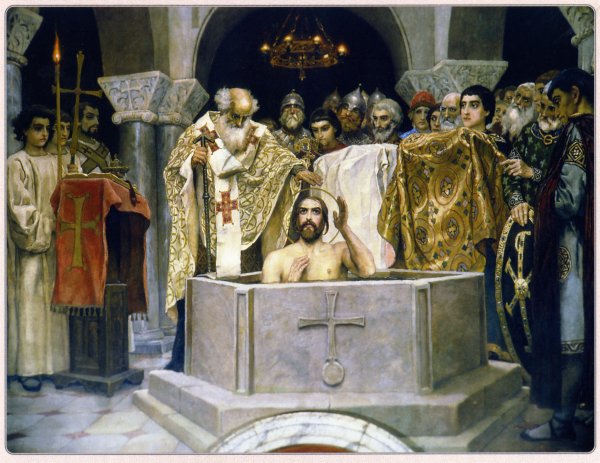
Viktor Vasnetsov
Baptism of Prince Vladimir
1885-1896
This picture depicts the sacrament of baptism of the Grand Duke of Kievan Rus Vladimir Svyatoslavich. First, he himself converted to Christianity, and then converted his subjects to the new faith.
At first, the third son of Prince Svyatoslav, like his father, was a pagan, and when he became the ruler of Kievan Rus, he began to think that his country should accept the faith that other nations profess.
The story about the beauty of the Sophia temple in Constantinople, about the majestic service that the Greeks hold in the Orthodox Church, interested him most of all. Maybe he thought: since faith is beautiful, then it is the most correct? Or did his grandmother, Princess Olga, a wise and courageous woman, sow in his soul the seeds of faith in Christ? Or maybe Prince Vladimir decided that having such a powerful state as Byzantium as an ally would be useful for the young Russian state?
The Grand Duke's desires did not differ from deeds: he did as he wanted. He was baptized, married a Byzantine princess, then converted his subjects to a new faith and began to build Christian churches in Kiev - almost as beautiful as in Constantinople.
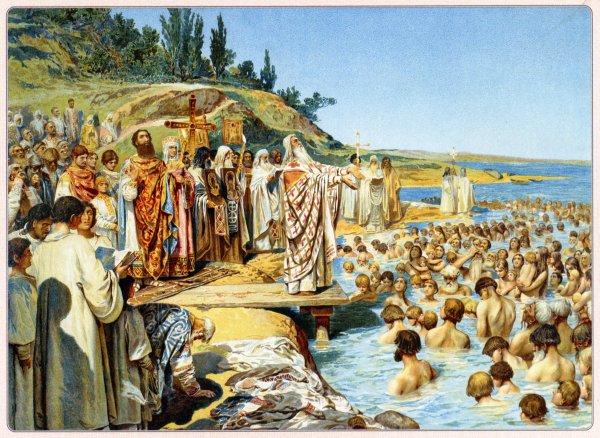
Claudius Lebedev
Baptism of Kiev
The Baptism of Russia is the introduction of Christianity as the state religion in Kievan Rus. It was carried out at the end of the 10th century by the Kiev prince Vladimir. Chronicles give different dates for the event. Scientists most often point to the year 988.
In Kiev, the baptism was quite organized, and most of the townspeople responded to the call of the prince. Along with baptism, the pagan temples were destroyed. In Kiev, wooden poles with images of the ancient gods carved on them were knocked to the ground. The oldest Christian churches in Kiev are considered to be the Church of the Tithes, built next to the fortress of the prince, the citadel, and the church of St. Nicholas in the lower part of the city, near the Dnieper. Perhaps it was erected on the site of the temple of Perun.
In other cities of Russia, the adoption of Christianity took longer and more difficult. Some peoples, for example, the Mari, having adopted Orthodoxy, remain faithful to ancient traditions - prayers in groves.
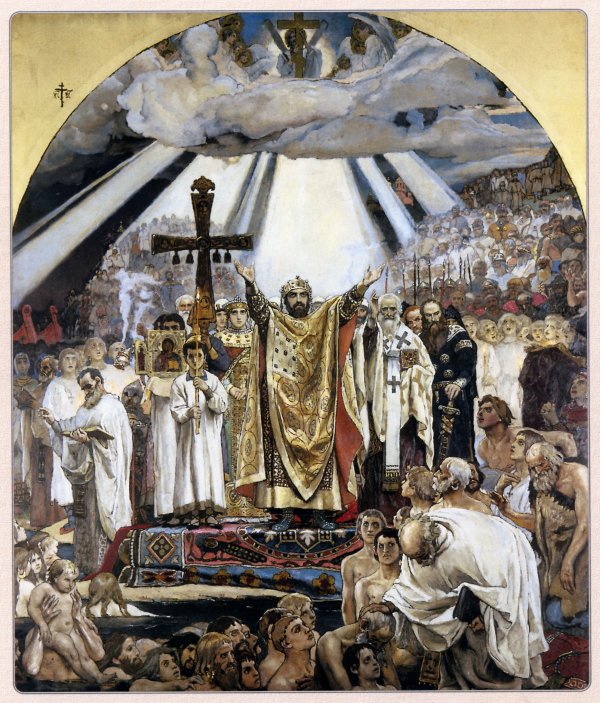
Viktor Vasnetsov
Baptism of Russia
1885-1896
The Baptism of Russia took place in Kiev in 988. The image of this event can be seen in the Kiev Cathedral, named in honor of the Baptist of Russia, the Vladimir Cathedral. The painting of the Vladimir Cathedral was entrusted to Viktor Vasnetsov. The artist initially rejected this proposal, but soon agreed. Before starting work, he went to Italy to study the monumental painting of the Renaissance.
For a long ten years, work was underway on the painting of the cathedral; M. Vrubel, N. Nesterov and other artists worked together with V. Vasnetsov. Vasnetsov painted almost 3,000 square meters in the cathedral, creating 15 paintings and 30 figures of saints, including Princess Olga, Alexander Nevsky, Nestor the Chronicler, Prince Vladimir, Saints Boris and Gleb and others.
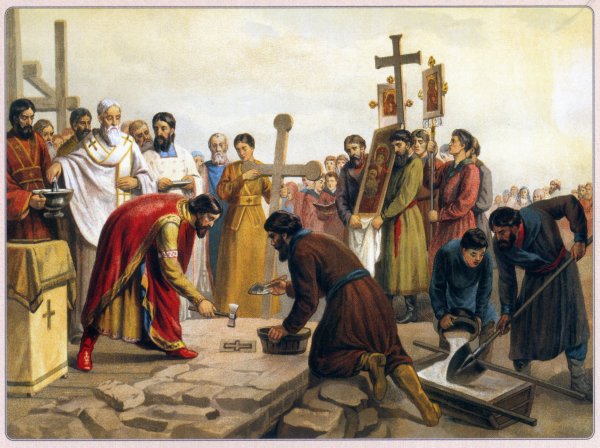
Vasily Vereshchagin
Bookmark of the Church of the Tithes
The picture shows the laying of the first stone Orthodox church in Kiev. It was built to the glory of the Assumption of the Mother of God, but more often it was called “Tithing” - according to a tenth of the prince's income, which were donated to the building, purchase of utensils and other needs of the temple.
Byzantine masons are visible in the picture, Grand Duke Vladimir is in a red cloak, behind him stands the first rector of the temple, Anastas Korsunyanin.
The church later housed the princely tomb.
The first Byzantine princess, Grand Duchess Anna, was buried in the church in 1011. Four years later, the tomb of her husband, Vladimir Svyatoslavich, the Baptist of Russia, was also installed here. The remains of Grand Duchess Olga were brought here from Vyshgorod and reburied. In 1044, Grand Duke Yaroslav the Wise ordered the posthumous baptism of Yaropolk and Oleg, brothers of Vladimir Svyatoslavich, and they found peace right there, in the Church of the Tithes.
Prince Vladimir brought many trophies and gifts from Korsun, with which he decorated the Kiev church, built on the site of the martyrdom of the Varangian Christians Theodore and John.
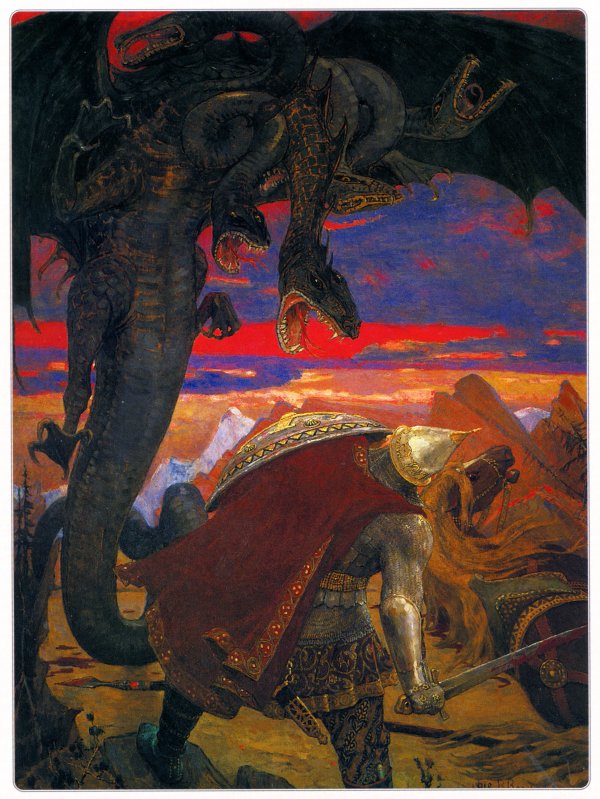
Viktor Vasnetsov
The fight between Dobrynya Nikitich and the seven-headed Serpent Gorynych
1918
In the picture, the hero of Russian epics Dobrynya Nikitich fights with the Serpent Gorynych. The prototype of Dobrynya Nikitich was Dobrynya, the maternal uncle of Grand Duke Vladimir Svyatoslavich. Uncle, at the behest of the prince, baptized the Novgorodians. The inhabitants of Veliky Novgorod were reluctant to accept the new faith and abandoned the old gods. The statue of Perun was thrown from the high bank to the Volkhov.
The battle between Dobrynya and the fabulous Serpent Gorynych symbolizes the victory of the Orthodox faith over paganism.
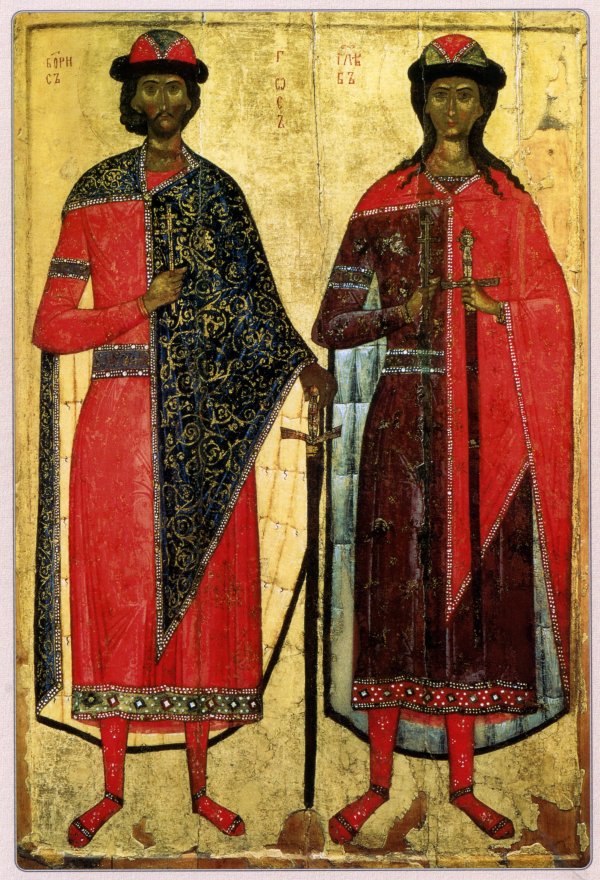
Icon
Boris and Gleb
14th century
The Russian princes Boris and Gleb are the first Russian saints by the time of canonization. Boris and Gleb were the youngest - the most beloved - sons of Vladimir Svyatoslavich, the Baptist of Russia. Their mother was the Greek princess Anna. According to The Tale of Bygone Years, Boris occupied the princely throne in Rostov, and Gleb in Murom, however, the Life of Boris and Gleb of the 11th century indicates that Boris reigned in Vladimir-Volynsky, and Gleb was with his father due to childhood. There is a version that Vladimir Svyatoslavich wanted to bequeath the throne of Kiev to Boris, whom he kept with him in the last years of his life. This would mean a complete revision of all the foundations, and could not but arouse the resistance of the older brothers - Yaroslav, who would later be called "The Wise" and the adoptive, Svyatopolk, who would be called the "Cursed".
It was Svyatopolk, by seniority, who occupied the throne of the grand duke after the death of Vladimir. Boris found out about this when he was returning at the head of his father's squad from a campaign against the Pechenegs - the squad wanted to support him in the struggle for the throne of Kiev. Boris refused, and most of the vigilantes left him. July 24, Sunday, Boris was killed while in his camp. And on September 5, Gleb, Boris's brother, was also killed. In the same year, Svyatopolk the Accursed killed Svyatoslav, their half-brother.
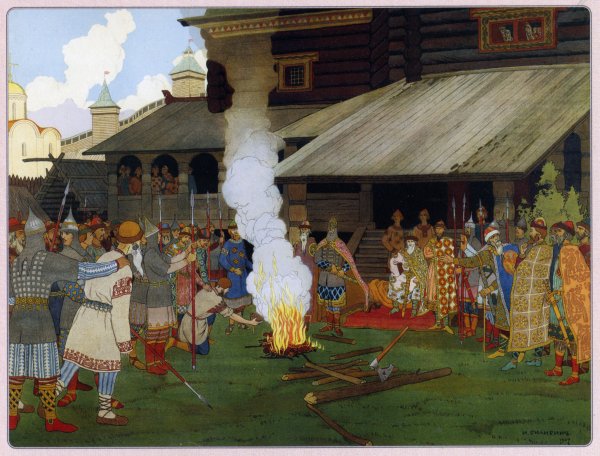
Ivan Bilibin
Court at the time of "Russian Truth"
1907
A bonfire burns in front of the prince's chambers. The old prince himself rules the court. Beside him stands his successor. On the right side of the picture, the boyar explains to the guest what is happening here. The disputants stand on the left. One of them knelt before the flame: now he will stretch out his hand and the fire will scorch it. If he can endure this pain, everyone will think he is innocent. If he pulls his hand away and screams in pain, then the combatant who stands behind the fire will cut off the guilty hand ...
In the left corner of the picture is the second debater, he is with a long gray beard. So he leaned forward, apparently, he wants to see what is happening, because he, too, will have to put his hand into the flame to prove his case. He would have done just that if he had not been held back by two princely combatants. Grand Duke Yaroslav the Wise is on the throne in front of the fire - it was during his reign that the first set of laws of “Russian Truth” was compiled.
The changing and improving norms of “Russian Truth” were in effect until the end of the 15th century, when the Sudebnik was introduced (1497).
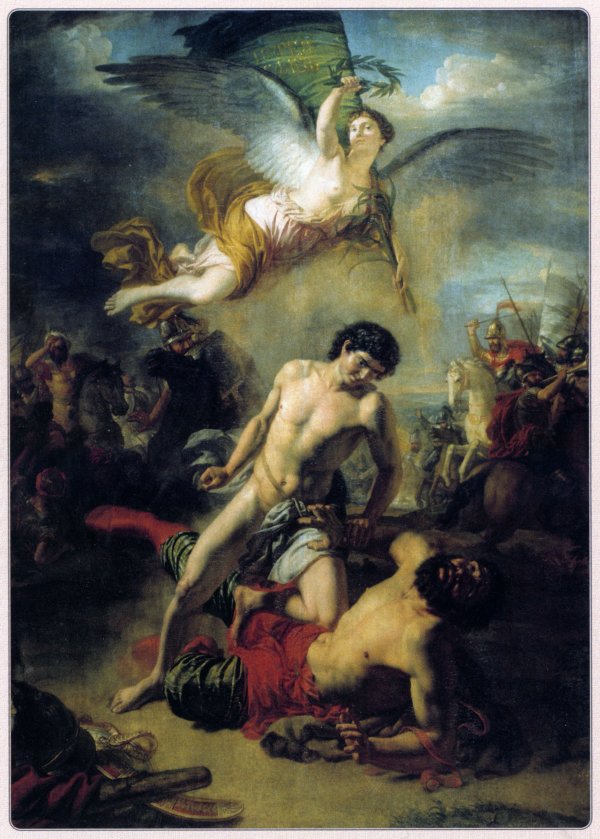
Andrey Ivanov
Single combat of Prince Mstislav Vladimirovich Udaly with the Kosozh prince Rededey in 1022 (Duel of Jan Usmar with the Pecheneg)
No later than 1812
Mstislav Vladimirovich Udaloy is the son of Grand Duke Vladimir Svyatoslavich. His possessions were on the Taman Peninsula. In those days, the Tmutarakan principality was located here.
Mstislav was distinguished by heroic strength, beauty, iron will and intelligence. He was a real defender of the southern borders of Kievan Rus.
In 1022 he went to war against the Kosogs. Kosozhsky Prince Rededya invited Mstislav to enter into single combat with him. Rededya was a strong man and hoped to quickly defeat Mstislav, but that was not the case. They fought for a long time. At first they fought with swords, then they threw aside their weapons and began to fight. Their fight went on for a long time. Mstislav, losing strength, turned to the Mother of God with a prayer, promising in case of victory to build a church in her honor. Finally, the Russian prince grabbed the scythe by the waist, lifted it and threw it to the ground with force. Rededia was defeated. And Mstislav annexed his lands, imposed tribute on the scythes. And he did not break his vow: he built the Church of the Virgin in Tmutarakan.
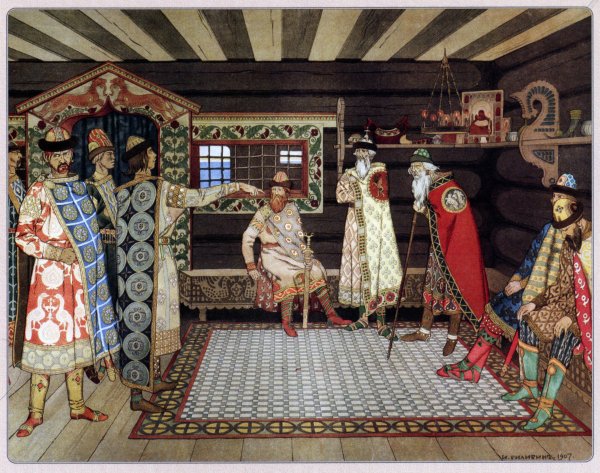
Ivan Bilibin
Congress of Princes
1907
Kievan Rus consisted of separate principalities ruled by the descendants of Rurik. Who should obey whom determined the ladder (“ladder”) rule. At the very top of the "ladder" was supposed to be an older relative - the Grand Duke of Kiev. After him, his younger brother was to rule, then the sons of the Grand Duke, then the sons of his younger brother. But it happened that the father wanted to leave power to his son.
To resolve all disputes about power, the princes gathered at congresses. One of these congresses is shown in the picture.
On the right is the Grand Duke of Kiev, next to him are his brothers. On the left are the young princes. It seems that they are not going to cede power in large cities to elderly relatives. But argument is better than war!
One of the most famous congresses of princes took place in 1097 in the city of Lyubech on the Dnieper (now a city in Ukraine). It was this congress that the artist captured. Grand Duke - Svyatopolk Izyaslavich. He received Kiev, Turov and Pinsk in possession (destiny). Vladimir Monomakh and Oleg Svyatoslavich began to rule in Pereyaslavl and Chernigov. Davyd Svyatoslavich received Ryazan as an inheritance. Davyd Igorevich - Vladimir-Volynsky, and Vasilko Rostislavich - Terebovl. At the same congress, the ladder right was abolished, deciding that everyone inherits the land of his father.
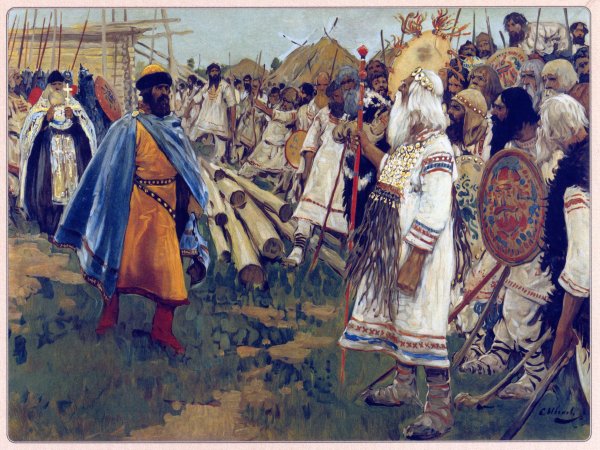
Sergey Ivanov
Christians and pagans. 1074 year.
1909
After the adoption of Christianity by Prince Vladimir and the Baptism of Russia, many years passed before the new faith was established everywhere - first in Kiev, then in large cities, on trade routes, gradually penetrating into the outback. The Magi (namely, as the pagan priests were called) did not like the new belief in a single god, for their own purposes they used the superstitions and fears of the common people, surrounding themselves with those who did not really have time to learn Christian teachings.
On the right side of the painting by S. Ivanov, one of these wise men is depicted, and on the left side, Prince Gleb of Novgorod. The sorcerer blasphemed the faith of Christ and showered abuse on the bishop. He even boasted that he would cross the Volkhov on foot, as if by land. Novgorodians listened to him attentively, listening to every word. The bishop (with a cross in his hands) stood in the square and called the faithful to the teachings of Christ, but the townspeople continued to crowd around the sorcerer.
Then the prince himself took over. Approaching the sorcerer, he asked him if the magician knew what would happen tomorrow morning, afternoon and evening? “I know everything,” answered the sorcerer.
“What will happen today”? the prince asked.
“I will perform great miracles,” the pagan priest replied.
As soon as he said this, the prince grabbed a previously hidden ax and cut off the sorcerer's head, thereby proving him wrong.
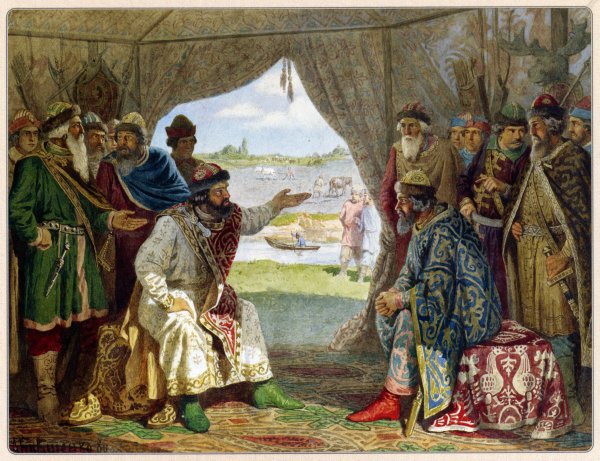
Alexey Kivshenko
Dolobsky Congress of Princes - a date between Prince Vladimir Monomakh and Prince Svyatopolk. 1103 year.
1880
Russian princes and governors gathered in a rich tent. On the left is Prince Vladimir Monomakh of Pereyaslavl. His southern principality suffered the most from the Polovtsian raids. Opposite him is the Kiev prince Svyatopolk Izyaslavich. The Grand Duke of Kievan Rus, he did not always behave wisely and sometimes seized the lands of specific princes. The nomads benefited from the strife: while the Russians were fighting among themselves, the steppes robbed them.
In 1103, the princes gathered near Kiev to unite against an external enemy. This congress was called "Dolobsky" - in the place where the prince's tent stood. Vladimir and Svyatopolk sent for other princes, Oleg and Davyd Svyatoslavich. Davyd responded to the call: "Let's go to the Polovtsians and come out alive or dead." But Oleg did not want to take part in the general campaign.
Immediately after the meeting, the squads on horses and boats moved along the Dnieper to the Polovtsian steppes. On April 4, a great battle took place at Suteni, from which the Russians emerged victorious. There were several more joint military campaigns of Svyatopolk, Vladimir and other princes, and again the Polovtsians were defeated. The threat from the south was destroyed.
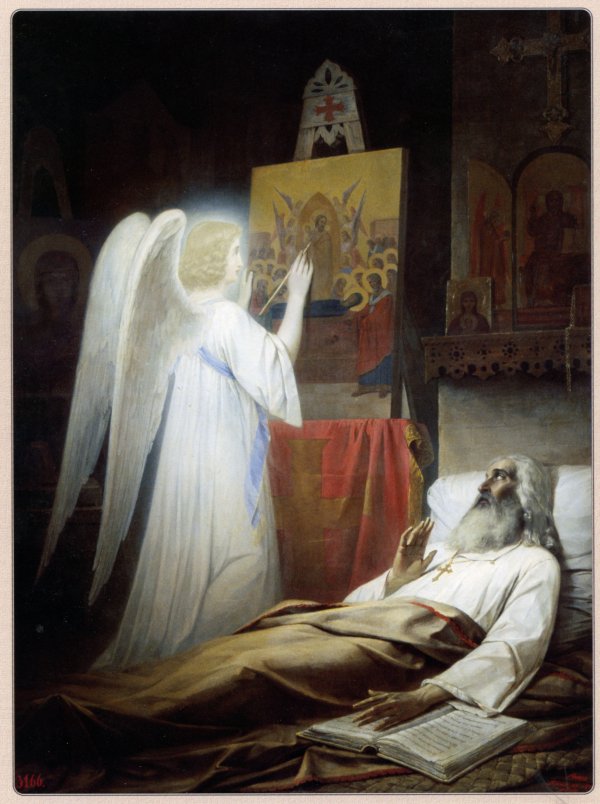
Vasily Raev
Blessed Alipy, icon painter of the Caves.
1848
Saint Alipy lived in Kiev in the 12th century. There were many wonderful events in his life. Once Alipiy was ordered to paint an icon of the Assumption of the Virgin. It so happened that the icon painter fell ill and felt that he could no longer get up. An impatient customer came to him and demanded that he complete the icon. Alipy said that everything would be as the Lord wants, and the icon would be painted on time. The customer continued to reproach the monk and left upset.
As soon as he left the cell where Alipy lay, a handsome young man appeared in it and began to finish the icon of the Assumption of the Mother of God. The monk at first thought that the customer had sent another artist. But, when he saw that light emanates from the young man, and he works skillfully and quickly, he understood: this is not a man, but an angel.
Having finished work on the icon, the angel asked Alipiy: “Have I written everything correctly? Maybe something is missing here? “You did everything very well,” replied the monk, “the Lord helped you in this work.” After that, the angel disappeared from the monk's cell.
The next morning the customer came to Alipiy with a heavy heart. And suddenly I saw an icon from which a magical light emanated. “Who painted this icon?” he asked the dying monk. Alipy said that at night an angel appeared in his cell, and he painted this icon. Then he took a deep breath and died.
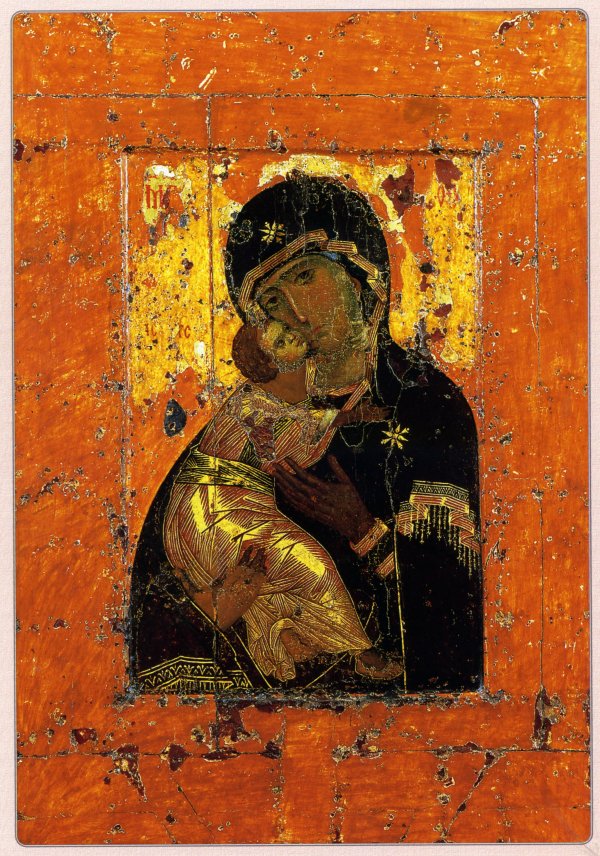
Icon
Our Lady of Vladimir
XII century.
The Vladimir Icon of the Mother of God is one of the most revered by the Russian people. It is very ancient: there is a legend that it was written by the Evangelist Luke. And he took the board for the icon from the countertop of the house where Jesus Christ lived in his youth. At this table, He daily ate food together with the Mother of God and Joseph.
Most likely, the icon was brought to Russia from Constantinople by Metropolitan Michael as a gift to Mstislav Izyaslavich, who at that time was the Grand Duke of Kiev. The prince decided that the most suitable place for the icon was a temple, and he gave it to a convent in Vyshgorod near Kiev. Andrei Bogolyubsky, who reigned in Vyshgorod, took the icon and left with it for Vladimir, where he remained to rule Russia. He gave the icon to the Assumption Cathedral.
There she stayed for 240 years, until the Grand Duke of Moscow demanded that she be brought to Moscow. And the reason for this was important: a huge army of Tamerlane was moving towards Moscow. There was only hope for the intercession of the Virgin. And She helped - Tamerlane had to get out. Since then, Our Lady of Vladimir has been considered an intercessor to enemies. Several copies (lists) were made from this icon, and all of them also have miraculous properties.
For a long time, the icon was kept in the Assumption Cathedral of the Moscow Kremlin, and now it is in the church-museum of St. Nicholas in Tolmachi at the Tretyakov Gallery.
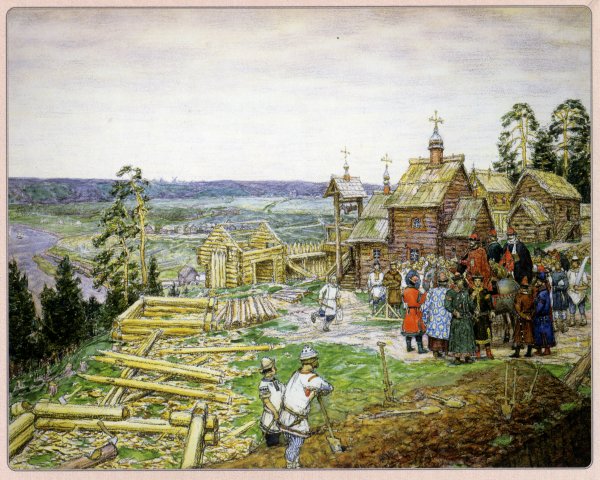
Apollinary Vasnetsov
Foundation of Moscow. Construction of the first walls of the Kremlin by Yuri Dolgoruky in 1156.
1917
The date of foundation of Moscow is considered to be 1147, it was then, according to the chronicle, that the Prince of Suzdal, Yuri Vladimirovich Dolgoruky, invited Prince Svyatoslav Olgovich to Moscow, arranging a “strong dinner” in his honor on March 28. The chronicle also mentions that in those days “there were villages of the red boyar of the good Kuchka Stepan Ivanovich on the Moscow River.” Dolgoruky, having stopped in these places, ordered the execution of the Suzdal boyar for his insolence and, fascinated by the beauty of these places, founded the city.
And nine years later he built a new “city”, a wooden fortress surrounded by a moat and a rampart, which covered an area five to six times larger. It is this historical moment that is depicted in the picture. Two centuries later, the white-stone fortress on Borovitsky Hill will be called the Kremlin.
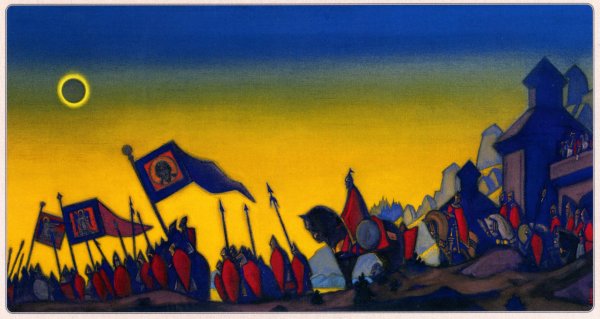
Nicholas Roerich
Igor's hike.
1942
Igor Svyatoslavich is the main character of The Tale of Igor's Campaign. For eighteen years he ruled in the principality of Novgorod-Seversky, and then for three years, until his death, he was the ruler in the largest principality of Kievan Rus - Chernigov.
Igor Svyatoslavich went to the Polovtsy more than once. His campaign of 1185 was sung in "The Tale of Igor's Campaign".
Igor with a small squad went to the steppe to teach the Polovtsy a lesson. However, a solar eclipse began. An alarming sign, according to ancient beliefs. But the prince ignored the "warning of heaven." Between Light and Darkness - red shields, like flashes of dawn. The prince was defeated and the Russian soldiers were left lying in the steppe ...
Roerich painted this picture in 1942, during the Great Patriotic War. Then the outcome of the war was unclear, but there was hope: we will definitely win! This is exactly what Nicholas Roerich wanted to say: everything repeats itself, and the campaign of the ancient Russians against the nomads was unsuccessful at first. The army was defeated, the prince was taken prisoner. But Igor managed to escape, he gathered a new army and defeated the Polovtsy.
The same thing happened in the war with the Nazis: in 1943, a “radical turning point” occurred, and the Russian soldiers drove the aggressor all the way to Berlin.
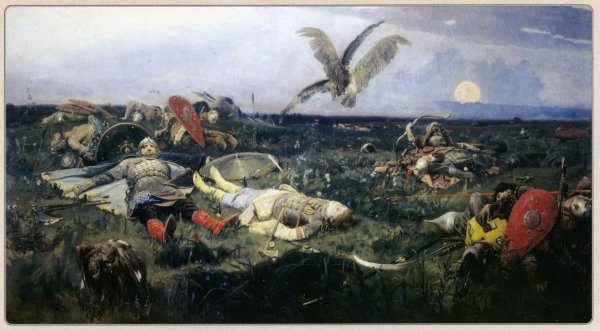
Viktor Vasnetsov
After the battle of Igor Svyatoslavich with the Polovtsians.
1880
This picture is an illustration to an outstanding monument of ancient Russian literature - "The Tale of Igor's Campaign", written at the end of the 12th century by an unknown author shortly after the unsuccessful campaign of Prince Igor Svyatoslavich of Novgorod-Seversky against the Polovtsians.
The work was preserved only in one handwritten list of the 16th century, which was acquired for his collection by the famous collector of antiquities A.I. Musin-Pushkin at the former archimandrite of the abolished Spaso-Yaroslavl Monastery. Unfortunately, the manuscript burned down during the Moscow fire of 1812, but the text preserved in the copy made for Catherine II, in the extracts of the historian Karamzin and in the printed edition containing errors, had a huge influence on the work of Zhukovsky, Pushkin, Ryleev, Gogol, Blok and many others. other prominent poets and writers.
The great monument of ancient Russian literature, newly opened to the reader, amazed everyone with its amazing versatility, historical significance, emotionally rich integrity of all facets of the artistic image. Many images of this unique epic work go back to the original Russian, folk symbolism, for example, the spontaneous connection of people with nature and the mention of pagan gods serve as historical evidence of the poetic views of the described era.
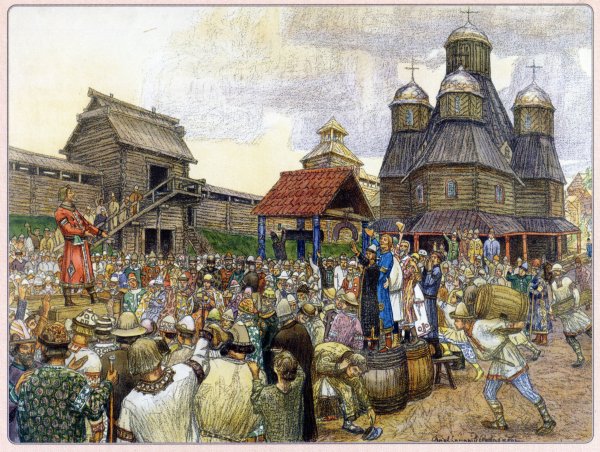
Apollinary Vasnetsov
Veche
Veche (from the Old Slavonic “vet” - “council”) is a national assembly in Russia. They came to the Veche to resolve issues that concerned all the inhabitants of the city. This form of problem solving has existed since ancient times. Over time, power was divided between the veche and the prince, and in different cities the “share” of this power turned out to be different. If the power of the prince was strong in Kiev, then in Novgorod he was treated only as a hired commander, and powers of authority were exercised by the posadnik and the thousand elected at the veche.
It was not necessary to come or speak at the veche: if you want, sit at home, and everything will be decided without you. But if you don’t want what is called “to be fooled”, go to Veche square and defend your interests.
There were no stipulated terms for convening the people at the veche: it met as needed. Sometimes several times a month, sometimes more than once a year. The order of where to be was also not prescribed, but still the people huddled together: the rich tried to stick together, supporters of one issue stood nearby, and their opponents threatened them with a brawl.
Decisions were not recorded, but in case of violation of the agreement, the perpetrator was punished. It also happened to be death.
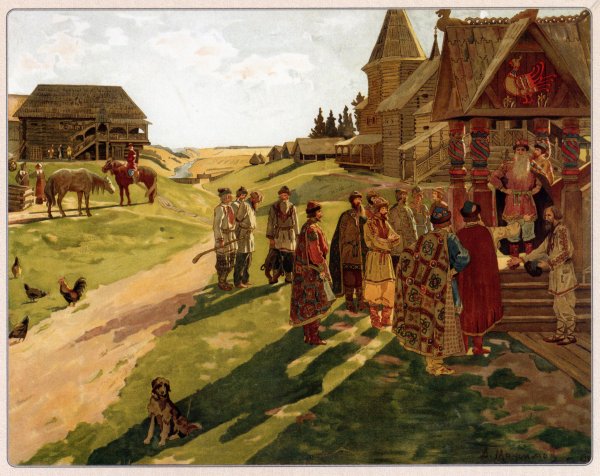
Alexey Maksimov
At the prince's estate
The prince - a strong old man with a gray beard - went out onto the painted porch of his choir. Before him are his subjects. They probably came to the prince to discuss important issues with him.
In the center of the picture is a peasant with a collar in his hands. Two fellows are holding the offender. The measure of his guilt must be determined by the prince: whether the peasant stole the collar, or took it for a while - and did not return it within the agreed time.
To the right, behind the prince's mansions, there are residential and outbuildings. On the left side of the picture is a large house for servants. We see girls at the well, poultry, horses... The prince was both a rich owner, and a commander, and the chief judge. Only he did not possess spiritual power.
In Kievan Rus, the main was the Grand Duke, at the head of the specific principalities were their own princes. They did not always obey the Kiev prince, and for this reason internecine wars took place, which did not contribute to the unity of the state, made it weak and not at all times capable of defending itself from external enemies.
Over time, Russia will expand its borders and become a kingdom, and then an empire, but the title of prince will not disappear. “Grand dukes” and “princesses” began to be called members of the royal family.
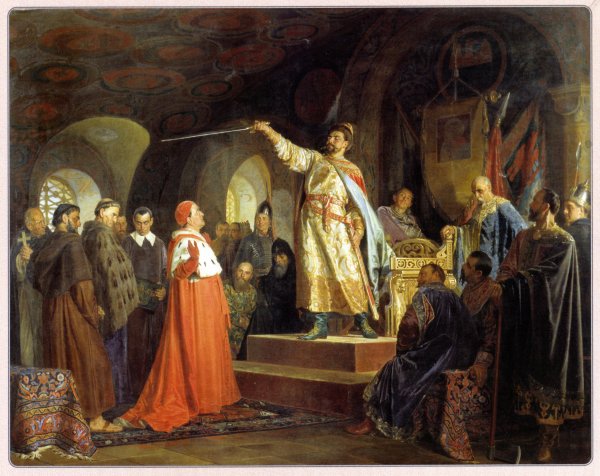
Nikolai Nevrev
Roman Galitsky receives the ambassadors of Pope Innocent III
1875
Prince Roman Mstislavich Galitsky (died in 1205) is one of the most famous and powerful rulers of Kievan Rus, a descendant of the Grand Duke of Kiev Yaroslav the Wise. Prince Roman Mstislavich reigned first in Novgorod the Great, then in Vladimir-Volynsky, and a little later he would also rule in Galich.
Roman Mstislavich subjugated the masterful boyars to his power. He forced all neighboring powers to respect Kievan Rus: Byzantium, Poland, Hungary.
The Catholic Church, seeing how the Russian state was growing stronger under the leadership of Prince Roman, decided to seduce him: he was offered to be crowned - you were a prince, you will become a king! But the prince could become king only by converting to the Catholic faith. And after the supreme ruler, all his subjects would have converted from Orthodoxy to Catholicism, which the Catholic priests so longed for.
But Russia had already chosen the Orthodox faith and did not want to change it. And the crown would add little to the power of Prince Roman Mstislavich.
In the picture, the prince shows the messenger of the pope to the door.
Previous post in the series:
The series will be continued in the next post, dedicated to the events of the XIII-XV centuries.
- In contact with 0
- Google Plus 0
- OK 0
- Facebook 0

